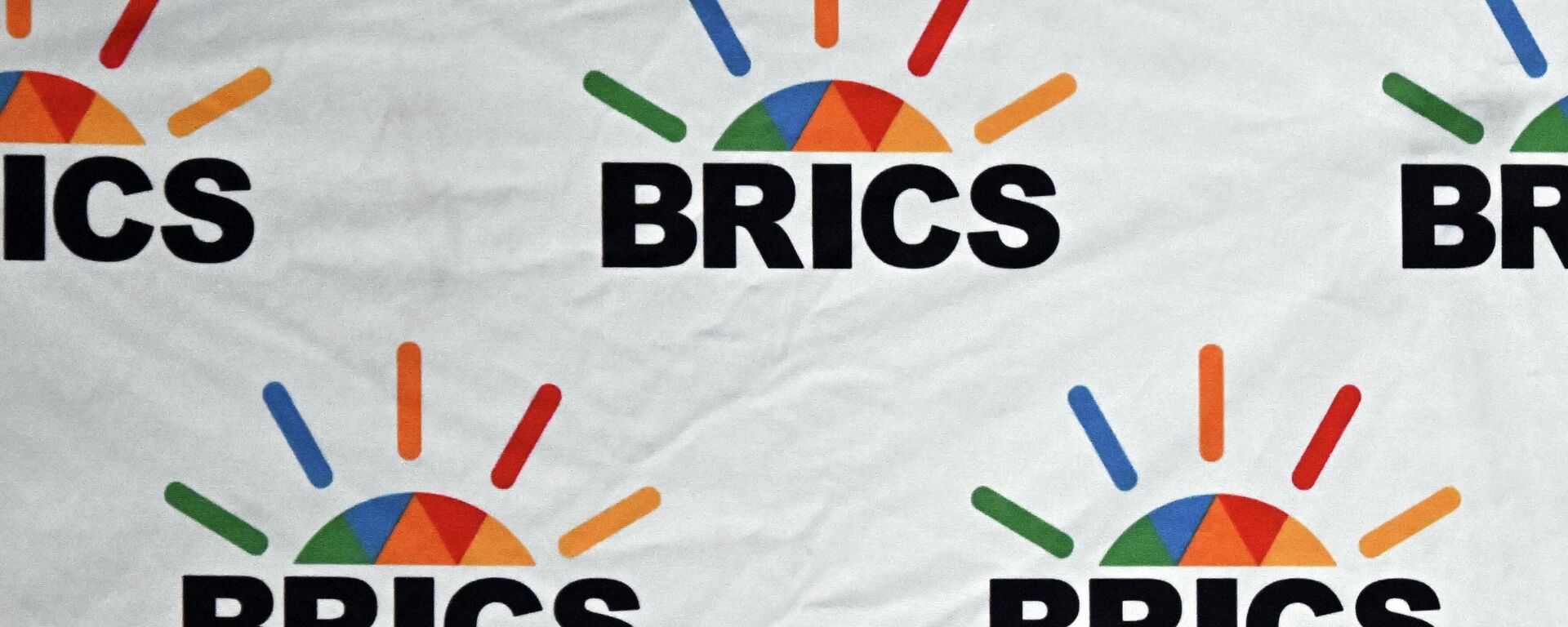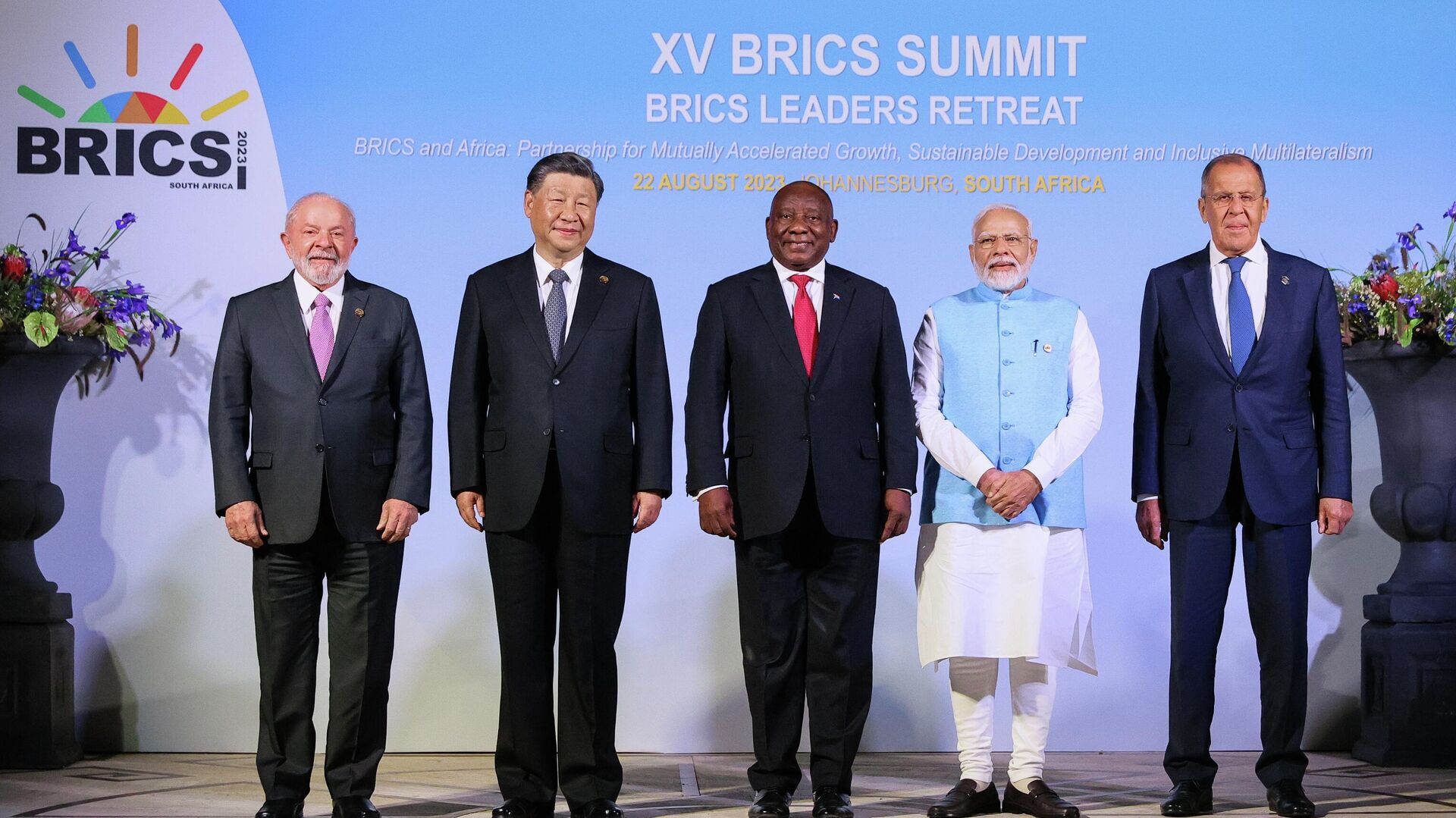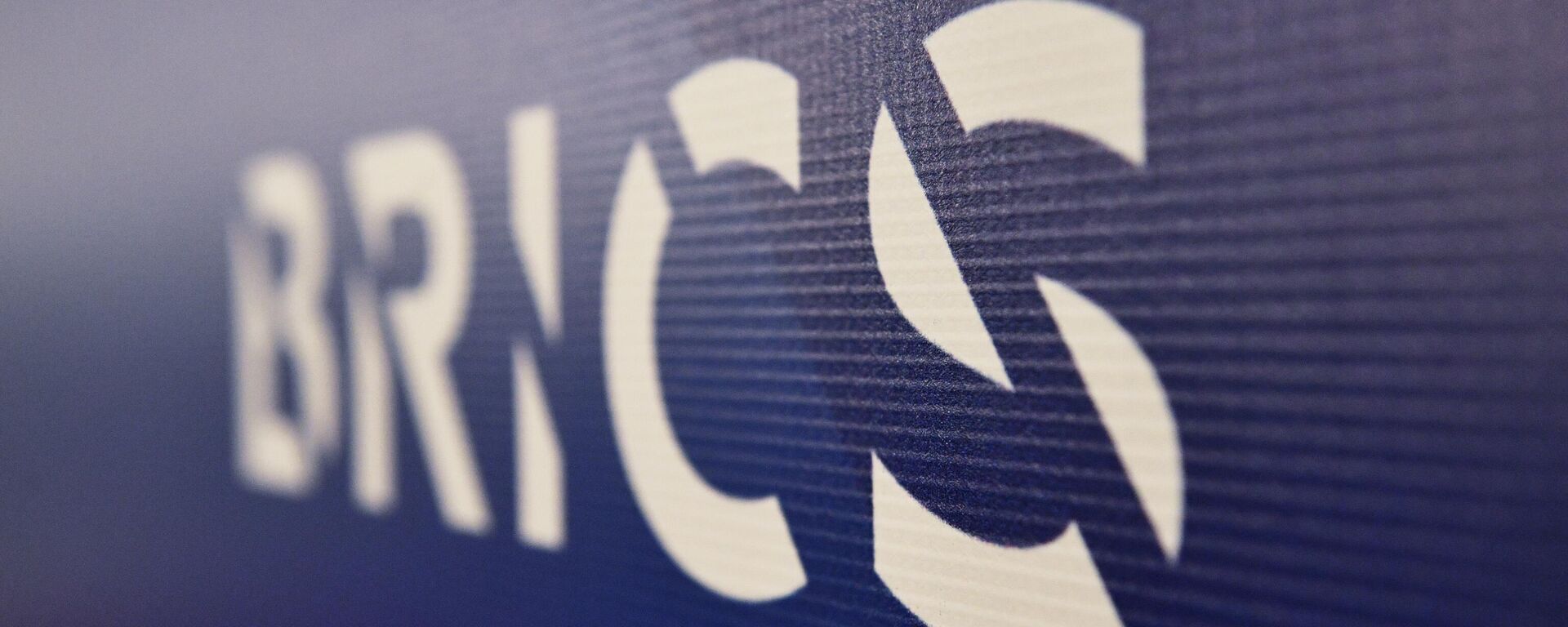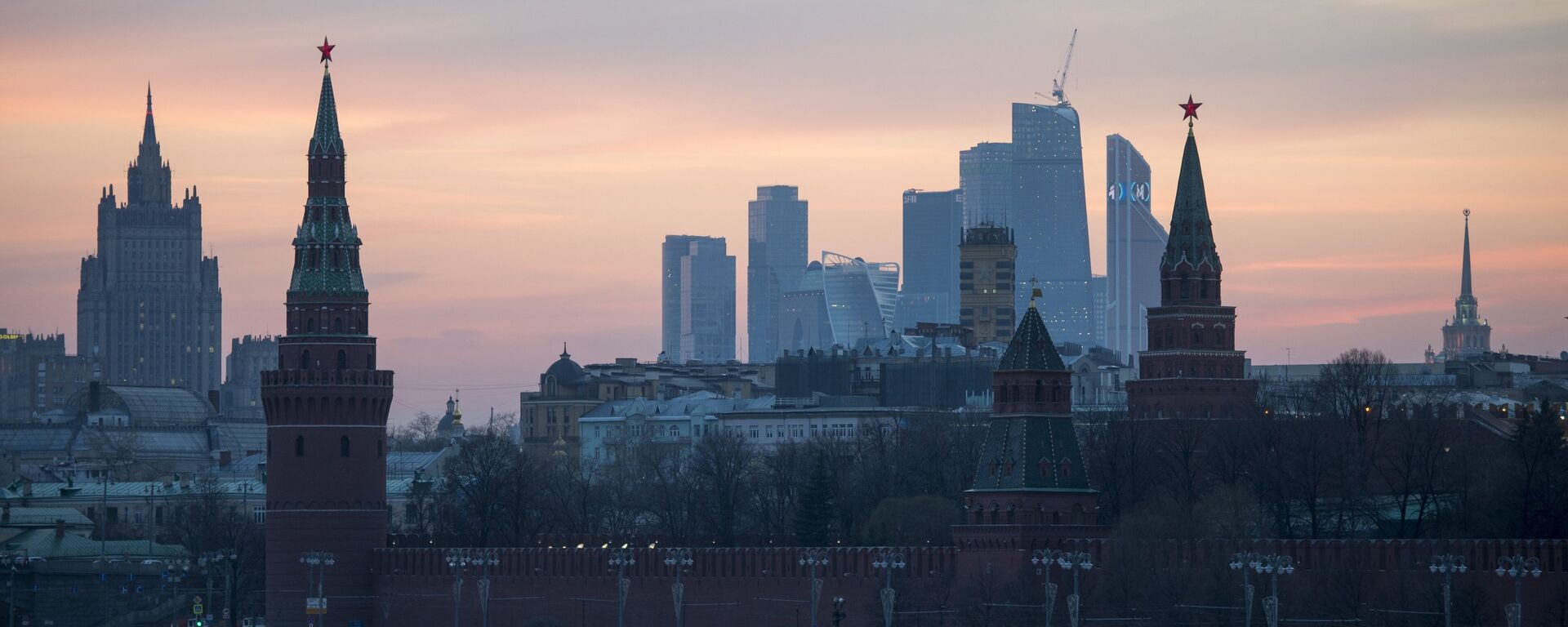https://sputnikglobe.com/20230827/what-to-know-about-the-new-brics-members-1112915345.html
What to Know About the New BRICS Members
What to Know About the New BRICS Members
Sputnik International
In a world shaped by geopolitical tensions and alliances, an abiding seismic shift takes the form of national interest and the East-West divide. The BRICS alliance emerges to take center stage; with the intriguing addition of six new member nations, the bloc is poised to redefine global dynamics.
2023-08-27T14:51+0000
2023-08-27T14:51+0000
2023-08-27T14:54+0000
world
newsfeed
cyril ramaphosa
ebrahim raisi
saudi arabia
iran
brics
shanghai cooperation organisation (sco)
argentina
opec
https://cdn1.img.sputnikglobe.com/img/07e7/08/17/1112805327_0:0:3058:1720_1920x0_80_0_0_5e625fe482a273b9e662578e530c79c2.jpg
The just-concluded 15th summit of BRICS (which includes Brazil, Russia, India, China, and South Africa) in Johannesburg attracted remarkable global watch, a level of prominence not witnessed since the group's inception 14 years ago. It marks the inaugural in-person BRICS gathering post the onset of the COVID-19 pandemic.Assuming the BRICS rotational presidency from China on January 1, 2023, South Africa declared its intention to organize the summit with the following theme: "BRICS and Africa: Partnership for Mutually Accelerated Growth, Sustainable Development, and Inclusive Multilateralism."Highlights of the summit included the BRICS Business Forum, Leaders Retreat, and a Summit Plenary.On Thursday, South African President Cyril Ramaphosa disclosed that BRICS, which held its 15th summit during the week, had extended invitations to six countries to join its ranks: Argentina, Egypt, Ethiopia, Iran, Saudi Arabia, and the UAE. Full membership is anticipated to come into force in 2024.Sputnik examines the newly invited BRICS members' fundamental economic data, opportunities they present, and their potential mutual benefits.BRICS+ Demography and GDP at a GlanceAccording to Sputnik's calculations, the BRICS+ nations currently have a total population of about 3.7 billion people, making up roughly 46.25 percent of the global population (which had exceeded eight billion by mid-November 2022). Nevertheless, the BRICS+ bloc's portion of Earth's habitable land area is estimated at 32.72 percent, totaling 48,779,373.6 out of 148.9 million square kilometers.*Total land area data was sourced from Statista.The population of the six new BRICS members and their land area:* Population data was sourced from The World Bank and Statista for total land area.In 2022, the overall world GDP amounted to about $100.5 trillion, and during that same year, the combined GDP of the BRICS+ bloc was nearly $30 trillion, constituting approximately 29 percent of global GDP. Moreover, the members of the BRICS+ GDP by PPP recorded a total of 60.14775 trillion last year.How the New BRICS Members Can Contribute to the BlocArgentinaArgentina's crucial position as an agricultural powerhouse and resource provider holds great significance for the food security and economic progress of BRICS nations. Its substantial agricultural exports ensure a reliable food supply, and its rich natural resources create opportunities for cooperation and investment. Strengthening bonds with Argentina can significantly contribute to the sustainability and growth of BRICS economies in various ways.According to 2022 data from El Instituto Nacional de Estadistica y Censos de la Republica Argentina (INDEC), the country witnessed a substantial uptick in merchandise exports, which rose by 13.5 percent, reaching a total of $88.4 billion. On the other hand, merchandise imports saw a significant jump of 29.0 percent, reaching $81.5 billion. The merchandise trade balance ended up with a relatively small surplus of $6.9 billion.Argentina's inclusion in the bloc will significantly fortify the group's lithium supply. Argentina possesses the world's third-largest lithium reserves. According to an August 2022 projection by JPMorgan, Argentina's percentage of global lithium production is expected to surge from six percent in 2021 to 16 percent by 2030, surpassing Chile and becoming the world's second-largest lithium producer by 2027. Argentina has 13 lithium projects in development, more than any other country, media sources say. It boasts 19 million metric tons of lithium, as per data from the Mineral Commodity Summaries 2022. With Argentina as a member, BRICS+ would count three of the world's top five lithium producers, along with China and Brazil.Argentina also has economic ties with blocs and regions such as MERCOSUR, Rest of ALADI, SICA, USMCA, the European Union, USMCA, the UK, Commonwealth of Independent States, Middle East, Arab Maghreb Union, South Africa Customs Union, and Oceania.EgyptAs of last year, the 2022 International Trade Statistics Yearbook’s Vol. 1 reported that Egypt registered a notable climb in the volume of its merchandise exports by 18.3 percent, gaining $48.1 billion, while merchandise imports rose by eight percent to $79.7 billion, yielding a trade deficit of $31.6 billion. The value of Egypt's service exports also increased by 46.4 percent to $32.1 billion, with service imports also growing by 26.7 percent to $29.1 billion, causing a relatively small services trade surplus of $3.0 billion.Between 2020 and 2022, Egypt's leading export was petroleum gases and other gaseous hydrocarbons. The top three countries that received these exports were Turkiye, Italy, and Saudi Arabia, making up 7 percent, 6.3 percent, and 5.3 percent of Egypt's total exports, respectively.Regarding services exports in 2021, the largest category was travel, with a value of $8.9 billion, followed closely by transport at $8.5 billion. These figures were reported in the yearly report on Egypt's trade and economic activities. Egypt's most significant import commodity during the period was petroleum oils and oils obtained from bituminous minerals, specifically crude oil. Transport represented the largest share of services imports in 2021, amounting to $10.4 billion. According to available data, other business services followed at $3.4 billion, and travel was the third-largest category at $3.3 billion.Egypt is part of the Arab Trade Zone (ATZ) and the African Continental Free Trade Agreement (AfCFTA). AfCFTA is particularly significant because it aims to eliminate tariffs on 98 percent of intra-African trade, promoting economic integration and cooperation among African countries.EthiopiaEthiopia's emergence as an African manufacturing hub presents opportunities for collaboration between the country and the BRICS nations. This collaboration can revolve around industrialization initiatives, infrastructure development, and capacity building, ultimately contributing to the economic development of Ethiopia and fostering BRICS-Africa cooperation.UN Comtrade data shows that in 2021, Ethiopia's merchandise exports surged by 20.7 percent to $3.1 billion, while imports grew by 8.5 percent to $15.3 billion, resulting in a trade deficit of $12.2 billion. In 2022, services exports rose significantly by 32.3 percent to $7.4 billion, but services imports also saw a substantial increase, reaching $8 billion, indicating a notable trade imbalance.A publication by the African Development Bank this year explained that in 2023 and 2024, Ethiopia's GDP is envisaged to jump from 5.8 and 6.2 percent, respectively, propelled by industry, private consumption, and investment growth drivers. The anticipated positive impacts of the peace dividend, a resurgence in tourism, and potential sector liberalization are expected to stimulate this growth further. Consequently, inflation is projected to decrease from 28.1 percent in 2023 to 20.1 percent in 2024.From 2019 to 2021, coffee (roasted or decaffeinated) stood as Ethiopia's primary export commodity. Conversely, the leading import commodity was petroleum oils, excluding crude. Notably, China, India, and Kuwait emerged as the foremost contributors to merchandise imports, comprising 27.8, 11.6, and 6.6 percent of the total imports, respectively.IranThe World Bank has anticipated 2.2 percent economic growth for Iran for the year 2023, a rate that exceeds the average global economic growth forecast.In 2018, Iran's merchandise exports dropped by 8.7 percent to $96.6 billion, while merchandise imports saw a significant decline of 20.1 percent to $41.2 billion. On the other hand, the country experienced a substantial 20.9 percent increase in the value of service exports, reaching $5.8 billion. However, service imports grew significantly, by 52.3 percent, reaching $11.1 billion, as documented by UN Comtrade.In 2021, the largest category in services exports was transport, totaling $1.9 billion, followed by construction at $353.1 million and other business services at $337.3 million. In terms of services imports for the same year, transport also held the top position with $3.8 billion, followed by other business services at $909.2 million, according to the global economic watchdog.Iran is a full member of the Shanghai Cooperation Organization (SCO) and has plans to connect its energy supply chains with SCO member countries' electricity networks. It plays a pivotal role in the International North-South Transportation Corridor (INSTC), facilitating trade between Europe, Russia, Turkiye, the Caucasus, and Central Asia with markets in East Africa, the Middle East, and South Asia. Additionally, Iran has a free trade agreement with the Eurasian Economic Union (EAEU), comprising Armenia, Belarus, Kazakhstan, Kyrgyzstan, and Russia.With over 700 million tons of lead and zinc geological reserves and approximately 170 million tons of recoverable reserves, the Mehdiabad Lead and Zinc and Barite Mine Complex is recognized as the second-largest reserve globally, per Hamid Reza Hemayat, the complex's director. Iran's membership in BRICS is expected to bring in investments, with copper, zinc, and lithium as potential commodities for trade in the future.Javad Owji, Iran's oil minister, revealed that, since President Ebrahim Raisi's inauguration in August 2021, 33 partially completed oil ventures, with a collective expenditure of $12 billion, have been initiated.Eurostat's data reveals that Iran's pistachio exports to the European Union during the first six months of 2023 (January to June) amounted to €48 million, indicating a 39 percent decrease compared to the same timeframe in the prior year.Iran's capacity as an energy provider (around 208.60 billion barrels in 2021 - accounting for 16.8 percent of the oil cartel's holdings, and roughly 33.98 trillion cubic meters of gas reserves in 2022 - based on OPEC's Annual Statistical Bulletin) and trading associate presents significant chances to enhance the energy security of BRICS+ nations and expand their economic collaboration. Developing closer connections with Iran may lead to mutually advantageous partnerships that support regional stability and economic advancement.Saudi ArabiaIn 2021, Saudi Arabia's merchandise exports surged by 54.3 percent to $286.5 billion, while imports rose by 16.3 percent to $152.7 billion. In 2022, the country's service exports soared by 284.3 percent to $39.6 billion, with service imports also up by 24.7 percent to $91.3 billion.In 2021, Saudi Arabia's top export commodities were mineral fuels, lubricants, chemicals, machinery, and transport equipment, making up 74.2, 16, and 3.6 percent of total exported goods, respectively. Travel was the leading category in the services sector, amounting to $3.8 billion, followed by transport at $2.7 billion.Between 2019 and 2021, the most significant import commodity for Saudi Arabia was motor cars and other motor vehicles designed for transport. For the same year, the leading categories for services imports were other business services, totaling $20.3 billion, transport at $16.8 billion, and travel at $12.2 billion.Saudi Arabia's Vision 2030, aimed at reducing its dependence on oil, offers collaboration opportunities for BRICS PLUS members in non-oil sectors like technology, manufacturing, and tourism, potentially boosting their economic ties.The kingdom’s active pursuit of foreign investments in infrastructure, technology, and renewable energy offers promising opportunities for BRICS+ members with their growing economies. Simultaneously, Saudi Arabia can tap into the capital and expertise of BRICS countries to facilitate its transformation. This reciprocal collaboration can drive economic growth for Saudi Arabia and the BRICS nations.Cooperation between Saudi Arabia and BRICS countries can stabilize global energy prices and ensure a steady oil supply for the BRICS club's energy security. Saudi Arabia has significant crude oil reserves (21.5 percent of OPEC’s stock) and other valuable resources like natural gas, iron ore, gold, and copper. It's part of OPEC, the Gulf Cooperation Council (GCC), the Arab Trade Zone, and works closely with the Shanghai Cooperation Organization.United Arab EmiratesIn 2021, the United Arab Emirates saw a significant increase in merchandise and service exports. Merchandise exports rose by 26.8 percent to $425.2 billion, while imports increased by 40.7 percent to $347.5 billion. Service exports also surged 30.4 percent to $101.8 billion, with service imports up 23 percent to $76.1 billion.Between 2019 and 2021, the United Arab Emirates' most significant export was petroleum oils and oils obtained from bituminous minerals and crude. In 2021, the country's biggest services exports were in travel, totaling $34.4 billion, transport at $24.8 billion, and insurance and pension services at $17.8 billion.The United Arab Emirates experienced notable trade patterns between 2019 and 2021. The largest import commodity during this period was gold (including gold plated with platinum). In 2021, the most substantial services imports were in insurance and pension services, amounting to $27.2 billion, followed by travel at $21.8 billion and transport at $12.5 billion.Dubai, a prominent metropolis in the United Arab Emirates (UAE), has established itself as a global financial center with a unique strategic position at the crossroads of Europe, Asia, and Africa. Its extensive infrastructure projects, encompassing top-tier airports, ports, and logistics hubs, align with the BRICS nations' goals of improving connectivity and trade facilitation. Collaborative ventures in infrastructure can reinforce these shared objectives.Dubai's significant investments in innovation and technology align with the BRICS countries' focus on technological progress. These investments can foster research, development, and technology-sharing partnerships. Dubai houses numerous technology parks and innovation incubators, providing a ripe environment for collaboration with BRICS nations to facilitate technology exchange, support startups, and cultivate an innovation-driven culture.
https://sputnikglobe.com/20230824/argentina-iran-saudi-arabia-egypt-uae-and-ethiopia-get-brics-membership-1112840923.html
https://sputnikglobe.com/20230802/how-much-does-brics-contribute-to-world-gdp-1112307546.html
https://sputnikglobe.com/20230602/argentina-can-reportedly-join-brics-new-development-bank-as-early-as-august-1110852911.html
https://sputnikglobe.com/20230824/joining-brics-will-allow-ethiopia-to-intensify-trade-cooperation--ambassador-in-moscow-1112848582.html
https://sputnikglobe.com/20220627/iran-asks-to-join-brics-1096724403.html
https://sputnikglobe.com/20230603/trade-turnover-between-saudi-arabia-brics-tops-160bln-in-2022-1110874086.html
https://sputnikglobe.com/20230616/russia-interested-in-trade-economic-cooperation-with-uae-other-countries-1111204006.html
saudi arabia
iran
argentina
Sputnik International
feedback@sputniknews.com
+74956456601
MIA „Rossiya Segodnya“
2023
Sputnik International
feedback@sputniknews.com
+74956456601
MIA „Rossiya Segodnya“
News
en_EN
Sputnik International
feedback@sputniknews.com
+74956456601
MIA „Rossiya Segodnya“
Sputnik International
feedback@sputniknews.com
+74956456601
MIA „Rossiya Segodnya“
brics summit, brics partnership, brics growth, brics development, brics inclusion, brics members, brics countries, brics expansion, brics new members, argentina brics, egypt brics, ethiopia brics, iran brics, saudi arabia brics, uae brics, brics demographics, brics gdp, brics economy, brics trade, brics collaboration, brics opportunities, brics benefits, brics economic data, brics summit highlights, brics business forum, brics leaders retreat, brics summit plenary, south african president cyril ramaphosa, brics rotational presidency, brics theme, brics+ union, global gdp, brics agriculture, argentina agricultural powerhouse, argentina natural resources, argentina lithium reserves, egypt trade statistics, egypt service exports, ethiopia manufacturing hub, ethiopia industrialization, iran economic growth, saudi arabia exports, uae trade, dubai innovation, brics infrastructure collaboration, brics plus
brics summit, brics partnership, brics growth, brics development, brics inclusion, brics members, brics countries, brics expansion, brics new members, argentina brics, egypt brics, ethiopia brics, iran brics, saudi arabia brics, uae brics, brics demographics, brics gdp, brics economy, brics trade, brics collaboration, brics opportunities, brics benefits, brics economic data, brics summit highlights, brics business forum, brics leaders retreat, brics summit plenary, south african president cyril ramaphosa, brics rotational presidency, brics theme, brics+ union, global gdp, brics agriculture, argentina agricultural powerhouse, argentina natural resources, argentina lithium reserves, egypt trade statistics, egypt service exports, ethiopia manufacturing hub, ethiopia industrialization, iran economic growth, saudi arabia exports, uae trade, dubai innovation, brics infrastructure collaboration, brics plus
The just-concluded 15th summit of BRICS (which includes Brazil, Russia, India, China, and South Africa) in Johannesburg attracted remarkable global watch, a level of prominence not witnessed since the group's inception 14 years ago. It marks the inaugural in-person BRICS gathering post the onset of the COVID-19 pandemic.
Assuming the BRICS rotational presidency from China on January 1, 2023, South Africa declared its intention to organize the summit with the following theme: "BRICS and Africa: Partnership for Mutually Accelerated Growth, Sustainable Development, and Inclusive Multilateralism."
Highlights of the summit included the BRICS Business Forum, Leaders Retreat, and a Summit Plenary.

24 August 2023, 07:49 GMT
On Thursday, South African President Cyril Ramaphosa disclosed that BRICS, which held its 15th summit during the week, had extended invitations to six countries to join its ranks: Argentina, Egypt, Ethiopia, Iran, Saudi Arabia, and the UAE. Full membership is anticipated to come into force in 2024.
Sputnik examines the newly invited BRICS members' fundamental economic data, opportunities they present, and their potential mutual benefits.
BRICS+ Demography and GDP at a Glance
According to Sputnik's calculations, the BRICS+ nations currently have a total population of about 3.7 billion people, making up roughly 46.25 percent of the global population (which had
exceeded eight billion by mid-November 2022).
Nevertheless, the BRICS+ bloc's portion of Earth's habitable land area is estimated at 32.72 percent, totaling 48,779,373.6 out of 148.9 million square kilometers.
India (
1,425,775,850) - 3,287,263 sq. km
China (
1,412,175,000) - 9,596,960 sq. km
Brazil (
215,313,498) - 8,515,770 sq. km
Russia (
146,447,424) - 17,098,242 sq. km
South Africa (
59,893,885) -1,219,090 sq. km
*Total land area data was sourced from Statista. The population of the six new BRICS members and their land area:
Argentina (46,234,830) - 2,780,400 sq. km
Egypt (110,990,103) - 1,001,450 sq. km
Ethiopia (123,379,924) - 1,104,300 sq. km
Iran (88,550,570) - 1,648,195 sq. km
Saudi Arabia (36,408,820) - 2,149,690 sq. km
United Arab Emirates (9,441,129) - 71,023.6 sq. km
* Population data was sourced from The World Bank and Statista for total land area. In 2022, the overall
world GDP amounted to about $100.5 trillion, and during that same year, the
combined GDP of the BRICS+ bloc was nearly $30 trillion, constituting approximately 29 percent of global GDP. Moreover, the members of the
BRICS+ GDP by PPP recorded a total of 60.14775 trillion last year.
How the New BRICS Members Can Contribute to the Bloc
Argentina's crucial position as an agricultural powerhouse and resource provider holds great significance for the food security and economic progress of BRICS nations. Its substantial agricultural exports ensure a reliable food supply, and its rich natural resources create opportunities for cooperation and investment. Strengthening bonds with Argentina can significantly contribute to the sustainability and growth of BRICS economies in various ways.
According to
2022 data from
El Instituto Nacional de Estadistica y Censos de la Republica Argentina (INDEC), the country witnessed a substantial uptick in merchandise exports, which rose by 13.5 percent, reaching a total of $88.4 billion. On the other hand, merchandise imports saw a significant jump of 29.0 percent, reaching $81.5 billion. The merchandise trade balance ended up with a relatively small surplus of $6.9 billion.
Argentina's inclusion in the bloc will significantly fortify the group's
lithium supply. Argentina possesses the world's third-largest lithium reserves. According to an August 2022
projection by JPMorgan, Argentina's percentage of global lithium production is expected to surge from six percent in 2021 to 16 percent by 2030, surpassing Chile and becoming the world's second-largest lithium producer by 2027. Argentina has 13 lithium projects in development, more than any other country, media sources say. It boasts 19 million metric tons of lithium, as per
data from the Mineral Commodity Summaries 2022. With Argentina as a member, BRICS+ would count three of the world's top five lithium producers, along with China and Brazil.
Argentina also has economic ties with blocs and regions such as MERCOSUR, Rest of ALADI, SICA, USMCA, the European Union, USMCA, the UK, Commonwealth of Independent States, Middle East, Arab Maghreb Union, South Africa Customs Union, and Oceania.
As of last year, the 2022 International Trade Statistics Yearbook’s Vol. 1 reported that Egypt registered a notable climb in the volume of its merchandise exports by 18.3 percent, gaining $48.1 billion, while merchandise imports rose by eight percent to $79.7 billion, yielding a trade deficit of $31.6 billion. The value of Egypt's service exports also increased by 46.4 percent to $32.1 billion, with service imports also growing by 26.7 percent to $29.1 billion, causing a relatively small services trade surplus of $3.0 billion.
Between 2020 and 2022, Egypt's leading export was petroleum gases and other gaseous hydrocarbons. The top three countries that received these exports were Turkiye, Italy, and Saudi Arabia, making up 7 percent, 6.3 percent, and 5.3 percent of Egypt's total exports, respectively.
Regarding services exports in 2021, the largest category was travel, with a value of $8.9 billion, followed closely by transport at $8.5 billion. These figures were reported in the yearly report on Egypt's trade and economic activities. Egypt's most significant import commodity during the period was petroleum oils and oils obtained from bituminous minerals, specifically crude oil. Transport represented the largest share of services imports in 2021, amounting to $10.4 billion. According to available data, other business services followed at $3.4 billion, and travel was the third-largest category at $3.3 billion.
Egypt is part of the Arab Trade Zone (ATZ) and the
African Continental Free Trade Agreement (AfCFTA). AfCFTA is particularly significant because it aims to eliminate tariffs on 98 percent of intra-African trade, promoting economic integration and cooperation among African countries.
Ethiopia's emergence as an African manufacturing hub presents opportunities for collaboration between the country and the BRICS nations. This collaboration can revolve around industrialization initiatives, infrastructure development, and capacity building, ultimately contributing to the economic development of Ethiopia and fostering BRICS-Africa cooperation.
UN Comtrade data shows that in 2021, Ethiopia's merchandise exports surged by 20.7 percent to $3.1 billion, while imports grew by 8.5 percent to $15.3 billion, resulting in a trade deficit of $12.2 billion. In 2022, services exports rose significantly by 32.3 percent to $7.4 billion, but services imports also saw a substantial increase, reaching $8 billion, indicating a notable trade imbalance.

24 August 2023, 11:01 GMT
A publication by the African Development Bank this year explained that in 2023 and 2024, Ethiopia's GDP is envisaged to jump from 5.8 and 6.2 percent, respectively, propelled by industry, private consumption, and investment growth drivers. The anticipated positive impacts of the peace dividend, a resurgence in tourism, and potential sector liberalization are expected to stimulate this growth further. Consequently, inflation is projected to decrease from 28.1 percent in 2023 to 20.1 percent in 2024.
From 2019 to 2021, coffee (roasted or decaffeinated) stood as Ethiopia's primary export commodity. Conversely, the leading import commodity was petroleum oils, excluding crude. Notably, China, India, and Kuwait emerged as the foremost contributors to merchandise imports, comprising 27.8, 11.6, and 6.6 percent of the total imports, respectively.
The World Bank has anticipated 2.2 percent economic growth for Iran for the year 2023, a rate that exceeds the average global economic growth forecast.
In 2018, Iran's merchandise exports dropped by 8.7 percent to $96.6 billion, while merchandise imports saw a significant decline of 20.1 percent to $41.2 billion. On the other hand, the country experienced a substantial 20.9 percent increase in the value of service exports, reaching $5.8 billion. However, service imports grew significantly, by 52.3 percent, reaching $11.1 billion, as documented by
UN Comtrade.In 2021, the largest category in services exports was transport, totaling $1.9 billion, followed by construction at $353.1 million and other business services at $337.3 million. In terms of services imports for the same year, transport also held the top position with $3.8 billion, followed by other business services at $909.2 million, according to the global economic watchdog.
Iran is a full member of the
Shanghai Cooperation Organization (SCO) and has plans to connect its energy supply chains with SCO member countries' electricity networks. It plays a pivotal role in the International North-South Transportation Corridor (INSTC), facilitating trade between Europe, Russia, Turkiye, the Caucasus, and Central Asia with markets in East Africa, the Middle East, and South Asia. Additionally, Iran has a free trade agreement with the Eurasian Economic Union (EAEU), comprising Armenia, Belarus, Kazakhstan, Kyrgyzstan, and Russia.
With over
700 million tons of lead and zinc geological reserves and approximately 170 million tons of recoverable reserves, the Mehdiabad Lead and Zinc and Barite Mine Complex is recognized as the second-largest reserve globally, per Hamid Reza Hemayat, the complex's director.
Iran's membership in BRICS is expected to bring in investments, with copper, zinc, and lithium as potential commodities for trade in the future.
Javad Owji, Iran's oil minister,
revealed that, since President Ebrahim Raisi's inauguration in August 2021, 33 partially completed oil ventures, with a collective expenditure of $12 billion, have been initiated.
Eurostat's data reveals that
Iran's pistachio exports to the European Union during the first six months of 2023 (January to June) amounted to €48 million, indicating a 39 percent decrease compared to the same timeframe in the prior year.
Iran's capacity as an energy provider (around 208.60 billion barrels in 2021 - accounting for 16.8 percent of the oil cartel's holdings, and roughly 33.98 trillion cubic meters of gas reserves in 2022 - based on OPEC's Annual Statistical Bulletin) and trading associate presents significant chances to enhance the energy security of BRICS+ nations and expand their economic collaboration. Developing closer connections with Iran may lead to mutually advantageous partnerships that support regional stability and economic advancement.
In 2021, Saudi Arabia's merchandise exports surged by 54.3 percent to $286.5 billion, while imports rose by 16.3 percent to $152.7 billion. In 2022, the country's service exports soared by 284.3 percent to $39.6 billion, with service imports also up by 24.7 percent to $91.3 billion.
In 2021, Saudi Arabia's top export commodities were mineral fuels, lubricants, chemicals, machinery, and transport equipment, making up 74.2, 16, and 3.6 percent of total exported goods, respectively. Travel was the leading category in the services sector, amounting to $3.8 billion, followed by transport at $2.7 billion.
Between 2019 and 2021, the most significant import commodity for Saudi Arabia was motor cars and other motor vehicles designed for transport. For the same year, the leading categories for services imports were other business services, totaling $20.3 billion, transport at $16.8 billion, and travel at $12.2 billion.
Saudi Arabia's Vision 2030, aimed at reducing its dependence on oil, offers collaboration opportunities for BRICS PLUS members in non-oil sectors like technology, manufacturing, and tourism, potentially boosting their economic ties.
The kingdom’s active pursuit of foreign investments in infrastructure, technology, and renewable energy offers promising opportunities for BRICS+ members with their growing economies. Simultaneously, Saudi Arabia can tap into the capital and expertise of BRICS countries to facilitate its transformation. This reciprocal collaboration can drive economic growth for Saudi Arabia and the BRICS nations.
Cooperation between Saudi Arabia and BRICS countries can stabilize global energy prices and ensure a steady oil supply for the BRICS club's energy security. Saudi Arabia has significant crude oil reserves (21.5 percent of OPEC’s stock) and other valuable resources like natural gas, iron ore, gold, and copper. It's part of OPEC, the Gulf Cooperation Council (GCC), the Arab Trade Zone, and works closely with the Shanghai Cooperation Organization.
In 2021, the United Arab Emirates saw a significant increase in merchandise and service exports. Merchandise exports rose by 26.8 percent to $425.2 billion, while imports increased by 40.7 percent to $347.5 billion. Service exports also surged 30.4 percent to $101.8 billion, with service imports up 23 percent to $76.1 billion.
Between 2019 and 2021, the United Arab Emirates' most significant export was petroleum oils and oils obtained from bituminous minerals and crude. In 2021, the country's biggest services exports were in travel, totaling $34.4 billion, transport at $24.8 billion, and insurance and pension services at $17.8 billion.
The United Arab Emirates experienced notable trade patterns between 2019 and 2021. The largest import commodity during this period was gold (including gold plated with platinum). In 2021, the most substantial services imports were in insurance and pension services, amounting to $27.2 billion, followed by travel at $21.8 billion and transport at $12.5 billion.
Dubai, a prominent metropolis in the United Arab Emirates (UAE), has established itself as a global financial center with a unique strategic position at the crossroads of Europe, Asia, and Africa. Its extensive infrastructure projects, encompassing top-tier airports, ports, and logistics hubs, align with the BRICS nations' goals of improving connectivity and trade facilitation. Collaborative ventures in infrastructure can reinforce these shared objectives.
Dubai's significant investments in innovation and technology align with the BRICS countries' focus on technological progress. These investments can foster research, development, and technology-sharing partnerships. Dubai houses numerous technology parks and innovation incubators, providing a ripe environment for collaboration with BRICS nations to facilitate technology exchange, support startups, and cultivate an innovation-driven culture.








